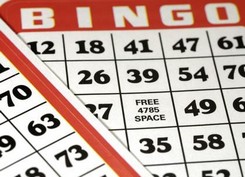 Bingo has been the quintessential charity game in the United States for most of a century. Expansions of the game (in terms of hours played and prize amounts) led to the court cases culminating in decisions that generated the initiation and widespread proliferation of Native American gambling in the United States. Bingo is also played in many commercial casinos. The game demands vigilance and attention from the players, who may form a collective audience of a dozen or several thousand (or more with satellite connections among several bingo halls).
Bingo has been the quintessential charity game in the United States for most of a century. Expansions of the game (in terms of hours played and prize amounts) led to the court cases culminating in decisions that generated the initiation and widespread proliferation of Native American gambling in the United States. Bingo is also played in many commercial casinos. The game demands vigilance and attention from the players, who may form a collective audience of a dozen or several thousand (or more with satellite connections among several bingo halls).
Bingo is played on two basic styles of cards. A bingo card in the United States has 25 spaces: 5 rows and 5 columns. Numbers are on 24 spaces; the center space has a star or another mark, designating it as a “free space.” The columns are designated as B, I, N, G, and O. Under the respective letters are numbers between 1 and 15, 16 and 30, 31 and 45, 46 and 60, and 61 and 75. In simple games, the object is to get 4 or 5 numbers called to fill a column, a row, or a diagonal line through the center or to fill in each corner of a card. More complex games may require filling in a pattern (for example, a letter T—top row and center N column; filling the outer edge—top and bottom rows and B and O columns) or covering all 24 numbers on the card.
The second type of card, popular in Europe, is called a tombola. The card has 3 lines and 5 columns. Each individual card has 5 numbers on a line, for 15 numbers in all. Eighty-one numbers are used in the game. Each game has 2 winners. The first winner is the one who first calls “bingo” when all 5 numbers of any one line are filled. The second winner is one who gets all 15 numbers on the card filled.
Although casinos and bingo halls may offer guaranteed prizes for winners of certain games, traditionally the prize pool has been taken from player purchases of cards, making the game a pari-mutuel player-banked exercise in gambling. If two or more persons win at the same time, the prize is divided. On big cover-all games, a bingo hall may offer a big prize if the cover-all is reached within a certain number of calls, for instance, forty-five numbers. If it is not, a part of the prize pool may be carried over to another day, and the big prize increased in a progressive manner.
In many Las Vegas casinos that cater to senior citizens, bingo offers a large return to the players. That practice is used as an incentive to draw in customers who are expected to play slot machines and other games between and after the bingo games.
The numbers called at the bingo game usually appear on Ping-Pong balls that blow about in a sealed cage. When a small tunnel to the cage is opened, one ball is sucked up into an area where a caller can take it. The number on the ball is called and then recorded on a board that all can see. The ball is usually held up so that it can physically be seen as well. If a player has a win, he (more appropriately she, as more players of bingo are women than men—quite different than almost all other games) must call out “bingo” before the next number is called. The bingo card is then verified to ensure that all numbers are on it and that it contains the last number called.
The percentage payout varies considerably, depending upon the desires for an operator to get a certain return from the players by setting prizes at a certain level. The bingo game utilized today is an outgrowth of a private Italian game called lotto. This in turn was derived from a national lottery game that began in the sixteenth century. Forms of bingo (called by other names) were played in the United States in the mid-nineteenth century. The popularity of the game was developed in the 1920s, when movie halls used it for raffle prizes given to those attending shows.
The American card used today in bingo is traced to the 1920s. The name bingo had been used as a reference to beans that players used to mark winning numbers.
Bingo has maintained a wide popularity due to its simplicity, its almost “pure luck” form, and the fact that it is a very social game that can be easily set up for commercial or charitable functions.
|
|